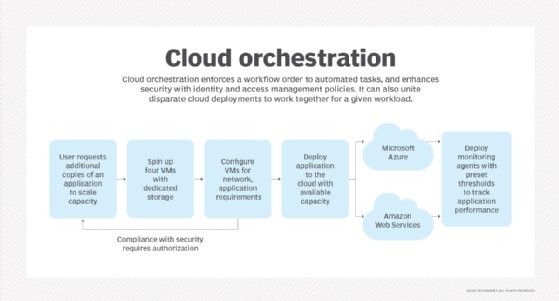
What is cloud orchestration (cloud orchestrator)?
Cloud orchestration (cloud orchestrator) is the use of programming technology to manage the interconnections and interactions among workloads on public and private cloud infrastructure. It connects automated tasks into a cohesive workflow to accomplish a goal, with permissions oversight and policy enforcement.
Cloud orchestration typically provisions, deploys or starts servers; acquires and assigns storage capacity; manages networking; creates virtual machines (VMs); and provides access to specific software on cloud services. This is accomplished through three main, closely related attributes of cloud orchestration: service, workload and resource orchestration. An orchestration platform can integrate permission checks for security and compliance.
Cloud orchestration technology must work with heterogeneous systems, potentially servicing a global cloud deployment in various geographical locations and with different providers. Many cloud orchestrator users run public cloud and private deployments.

Why is cloud orchestration important?
Today's IT landscape includes the growing adoption of microservices and containerized applications. These applications use application programming interfaces to communicate so the demand for cloud orchestration software to manage complex dependencies across multiple clouds has increased.
As hybrid cloud adoption grows, orchestration tools for both public and hybrid clouds become increasingly important. Cloud orchestration reduces manual IT tasks, automates resource allocation, minimizes errors and frees up resources, enabling faster application deployment across hybrid IT infrastructures.
Cloud orchestration is also crucial for managing workload interactions and making sure different services and applications work together seamlessly within a hybrid cloud environment. By automating tasks such as provisioning servers, setting up VMs, and scaling and deploying applications, cloud orchestration reduces manual effort, minimizes human error and enables organizations to adapt quickly to changing business demands.
Cloud orchestration vs. cloud automation
Cloud orchestration and cloud automation are closely related concepts in cloud computing, but they serve different purposes and operate at different levels of complexity. The following are the key differences and similarities between cloud automation and cloud orchestration.
Cloud orchestration features
- Cloud orchestration brings high availability, scalability, failure recovery, dependency management and numerous other attributes into a single process to reduce manual effort.
- Orchestration also provides visibility into resources and processes that cloud automation lacks. For example, a business can regulate capacity through preset resource templates for application deployment and track resource requests.
- Orchestration manages complex workflows that involve multiple automated tasks. For instance, orchestrating the deployment of a multi-tier application might involve provisioning servers, configuring networks and deploying applications in a specific order.
- Orchestration requires a more sophisticated approach, as it must consider the relationships between tasks, error handling and the overall workflow for successful execution.
- Orchestration is essential for managing complex environments, such as hybrid clouds, where multiple services and applications must work together efficiently.
Cloud automation features
- Cloud automation is a subset of orchestration, which means orchestration provides coordination among and across many automated activities.
- Automation is often used for repetitive tasks that need to be performed consistently, such as backups or updates.
- Automation focuses on performing tasks with minimal operator intervention. For example, automating the deployment of a VM is a typical and straightforward automation task.
- Automation tools typically include scripts and configuration management tools such as Ansible, Puppet and continuous integration/continuous delivery (CI/CD) pipelines.
Cloud orchestration benefits
Cloud orchestration is of interest to many IT organizations and DevOps adopters to speed up service delivery and reduce costs. The following are some key benefits of cloud orchestration:
- Centralized management and automation. A cloud orchestrator automates the management, coordination and organization of complicated computer systems, services and middleware. It achieves this by enabling users to define and manage the entire lifecycle of applications and infrastructure through a single and unified interface.
- Reduced risk of errors. Orchestration eliminates the potential for errors introduced during provisioning, scaling or other cloud processes through automated processes and standardized workflows.
- Standardization and security. Orchestration software helps IT organizations standardize templates and enforce security practices. It's also a good defense against VM sprawl, providing visibility into, and control over, cloud resources and costs. Because the orchestrator platform oversees interactions of many disparate elements of the application stack, it simplifies the communication and connections from one workload to other apps and users. It also ensures links are correctly configured and maintained. Such products usually include a web-based portal, so orchestration can be managed through a single pane of glass.
- Self-service management. Orchestration supports the delivery of cloud resources to customers and end users, including in a self-service model where users request resources without the IT team's help. The centralized nature of an orchestration platform provides administrators with the ability to review and improve automation scripts. In advanced organizations, developers and line-of-business workers can use cloud orchestration software as a self-service mechanism to deploy resources. In addition, administrators use it to track the organization's use of various IT offerings and to manage chargebacks.
- Cost optimizations. Cloud orchestration permits automated scaling of resources based on demand, enhancing cost management. This dynamic scaling prevents unnecessary resource consumption and overprovisioning, leading to reduced operational expenses and improved cost efficiency.
- Consistency across environments. Cloud orchestration manages consistency across environments by automating the provisioning and configuration of resources according to predefined templates and policies. This ensures that all environments, including on-premises data centers, public clouds and hybrid setups, are configured identically, minimizing inconsistencies and reducing the risk of errors.
Limitations of cloud orchestration
There are times when organizations might encounter certain challenges when setting up and running cloud orchestration. Common challenges and limitations of cloud orchestration include the following:
- Complexity. Setting up cloud orchestration can be complex, particularly in large or intricate environments. It often requires specialized knowledge in cloud infrastructure, automation and cloud security. A strong skill set in cloud architecture, DevOps or cloud automation is typically necessary for successful setup and ongoing management of cloud orchestration platforms.
- Potential security risks. While orchestration tools offer security features, any misconfigurations or vulnerabilities in the orchestration layer itself can create significant security risks for organizations. For example, if roles, permissions or access controls aren't set correctly, unauthorized users or services might gain access to sensitive data or critical systems, leading to potential breaches.
- Limited control. When an organization uses a cloud orchestration tool that isn't hosted on its on-premises servers, it loses some ability to customize its infrastructure. It also becomes more dependent on the features and limitations of the cloud service provider. In addition, the organization needs a stable internet connection to access its data and manage the environment, which reduces its direct control over the setup and operation of the cloud infrastructure.
- Issues with tools. Cloud orchestration tools sometimes present challenges for organizations. For example, while open source orchestration tools offer flexibility, they are prone to inconsistencies and bugs, requiring frequent updates and troubleshooting. On the other hand, commercial cloud orchestration tools provide stability but come with licensing fees and other potential charges.
Cloud orchestration models and delivery types
Cloud orchestration can be categorized into the following two primary models:
- Single-cloud orchestration. This model involves managing applications and services within a single cloud service provider. The uniformity of the environment simplifies configuration and management.
- Multi-cloud orchestration. This model integrates services and applications across multiple cloud providers, enabling organizations to use the strengths of different platforms. However, it can introduce certain complexities in management and interoperability of applications.
Cloud orchestration services are often embedded within distinct delivery models such as software as a service (SaaS), platform as a service (PaaS) and infrastructure as a service (IaaS) models:
- IaaS-based orchestration. This is the most common delivery model. Orchestration tools are used to manage and automate the provisioning, scaling and management of IaaS resources such as VMs, storage and networking within a cloud provider's environment.
- PaaS-based orchestration. PaaS orchestration focuses on automating the deployment and management of applications and their dependencies. This can include features such as automated scaling, CI/CD pipelines and application lifecycle management.
- SaaS-based orchestration. While not as common, orchestration capabilities can be integrated into SaaS platforms. For example, a SaaS application might offer features to automate workflows or integrate with other cloud services.
Key considerations for a cloud orchestration tool
When choosing a cloud orchestration tool, it's important that it aligns with the organization's needs and orchestration goals.
To evaluate cloud orchestration products, administrators should first map the workflows of the applications involved. This step will help the administrator visualize how complicated the application's internal workflow is and how often information flows outside the app component set. This, in turn, can help the administrator decide which type of orchestration product will help automate the workflow best and meet business requirements in the most cost-effective manner.
Key considerations include the following:
- Integration capabilities. To avoid being tied to a single vendor and to effectively pursue a multi-cloud strategy, the orchestration platform should work seamlessly with various cloud providers and technologies. Selecting tools that provide an abstraction layer is crucial for simplifying the management of diverse cloud environments.
- Scalability. As an organization grows, its orchestration tool should scale accordingly. It must handle increasing workloads and support the dynamic nature of cloud resources without compromising performance.
- Intuitive user interface. The cloud orchestration tool should have an intuitive interface that simplifies the orchestration process. A user-friendly design can reduce the learning curve for the team and improve productivity.
- Control and visibility. A good orchestration tool should improve visibility into the cloud environment, allowing operations teams to monitor tasks and workflows easily. This visibility is crucial for managing resources effectively and guaranteeing compliance with audit trails.
- Security features. When selecting a cloud orchestrator, organizations should look for a tool that offers robust security measures such as role-based access control, encryption and compliance monitoring.
- Automation. Businesses should prioritize orchestration tools that offer strong automation features so repetitive tasks and workflows can be automated. This capability is crucial for enhancing efficiency and minimizing human error.
- Support and community. A cloud orchestration tool should offer strong support and have an active community to provide resources such as documentation, FAQs and customer support. This minimizes downtime, fosters knowledge sharing and reduces reliance on vendor support.
Cloud orchestration vendors
Many vendors and cloud platform services offer cloud orchestrator products. DevOps teams can use cloud orchestration in numerous ways via automation and management tools to fit with their processes and methodologies.
In general, cloud orchestration tools operate similarly across public, private and hybrid clouds, though the specifics of a given use case might favor the features of one over another. For example, VMware's Aria Suite includes a hybrid cloud management platform that automates the delivery of cloud infrastructure, applications and services. It also has an operations component to help with planning, management and scaling; real-time log management and analysis; and automated costing, use metering and service pricing.
Other cloud orchestration vendors according to research conducted by Informa TechTarget editors include the following:
- Amazon Web Services CloudFormation enables users to define and provision AWS infrastructure using code. It simplifies the management of AWS resources and automates the deployment process.
- CloudFX provides unified management, automation and visibility across hybrid cloud environments, which helps organizations optimize their cloud operations and resources.
- IBM Cloud Orchestrator focuses on integrating the IBM Cloud with existing infrastructure policies and processes. It's especially suitable for organizations that already use other IBM tools.
- Ingram Micro Cloud Orchestrator is designed to simplify cloud initiatives. It automates and orchestrates the deployment and management of workloads across various environments, including private, public, hybrid and multi-cloud setups.
- Kubernetes is an open source container orchestration platform that streamlines containerized applications and Linux container processes in the cloud. Kubernetes automates many manual tasks related to deploying, scaling and managing containerized apps.
- Microsoft Azure Automation is a cloud service that enables users to automate frequent, time-consuming and error-prone IT management tasks across Microsoft Azure and on-premises environments. It uses runbooks, process automation and other features to help organizations reduce operational costs, minimize errors and enhance efficiency.
- Microsoft Azure CycleCloud is an enterprise-level tool designed for orchestrating and managing high-performance computing environments on Azure. It lets users provision infrastructure for HPC systems and provides a flexible and secure cloud computing environment for demanding workloads.
- Morpheus cloud orchestrator is a multi-cloud management platform that lets organizations automate and unify their cloud operations across various environments, including on-premises and in public clouds.
- OpenStack Heat orchestration engine within the OpenStack cloud platform is designed to manage the entire lifecycle of infrastructure and applications through a declarative template format.
- Red Hat Ansible is an open source automation platform that simplifies IT tasks, such as provisioning, configuration management and application deployment through a declarative language. It operates in an agentless manner and doesn't require any software to be installed on the managed nodes.
- SaltStack is designed to automate IT operations across complex infrastructures. Its key features include high-speed data collection, remote execution capabilities and a primary/secondary architecture. It lets administrators efficiently manage and maintain system states, automate configuration tasks and orchestrate workflows in on-premises and cloud environments.
- Zymr optimizes cloud infrastructure by automating management tasks, streamlining workflows, and ensuring secure and agile cloud environments for businesses using hybrid and multi-cloud strategies.
A cloud capacity management plan helps IT teams efficiently manage resources and optimize cloud workload performance. Learn the key steps to building a cloud capacity management plan.







